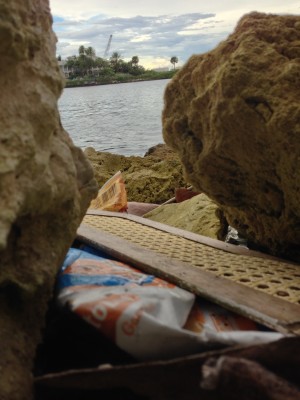Dirty Bay
We see it every day, it’s always constant, and therefore has become such an accustomed sight that it is taken for granted. Our beautiful Tampa Bay has lured tourists for years, yet the natives no longer see the awe of such a large body of water only right outside their doorstep.
Most residents of the Bay Area have experienced all sides of the bay; the calm days, the stormy days, and even the floods so violent they turn the famous Bayshore Boulevard into the Kongo River rapids. However, it’s not always the water’s violent tantrum that causes concern amongst the citizens of Tampa. Often what lies beneath –or sometimes floats atop –the surface of our beloved bay is more dangerous than the effect of Florida’s haphazard weather.
The litter that resides among the waves has only increased over these past couple of years, causing many environmentalists to question the true quality of the water that is so present in the city’s life. The overall depth of the bay’s floor is shallow, ranging around 12 feet. Yet, areas of high boat traffic can reach as deep as forty-three feet. These particular areas were dredged in order to accommodate the massive barges and passenger ships that dock at Tampa’s port. Florida’s largest port resides in Tampa, this only adds to the danger of the pollution lurking in our waters. According to The Florida Department of Environmental Protection’s Basin Status Report, “More than 4 billion gallons of oil, fertilizer products, and other potentially hazardous materials pass through Tampa Bay each year”. Although the bay is fed by an estuary then filtered into the Gulf of Mexico, natures natural purification doesn’t make up for the amount of man made waste so carelessly dropped into our waters.
However, this rapid contamination has not gone unnoticed by the city conservationist officials. Many organizations have been prompted to raise awareness of the dwindling health of our waters, spurring action to be taken. Academy Alumni Alecia Jurado, currently majoring in Environmental Science at Florida State University, provided her view on the Bay Area’s cleanup efforts. “Tampa Bay was once one of Florida’s most diverse and environmentally prosperous estuaries. By the 1970s, the bay’s essential sea grass beds had decreased by more than 80% and the water was so murky that sunlight hardly reached the bottom of the bay’s most shallow waters. I’m happy to say that since then the bay has gone through extensive environmental reconstruction”.
Just as Jurado states, the Bay Area has come a long way since the bay’s pollution became an obvious threat. Even though large amounts of work have been put into the preservation of our waters, more is still needed in order to truly repair the damage done.
Our bay is our responsibility, a slice of natural ecosystems in which we co-exist. “It’s easy to take for granted the sparkling waters that exist just outside Academy’s front door.” Says Jurado.
“AHN has always been actively involved in the community but what we sometimes forget is that the bay is the natural structure that created Tampa’s community in the first place. The biggest thing I think AHN girls can do is get educated – learn about our bay’s rich environmental history and pass on its importance to other people. I truly believe that environmental education is the key to preserving the beauty of our natural world. You never know – what you learn may even lead you to your future career.”
For those of us here at AHN who wish to actively contribute to our bay, Jurado recommends non-profit organizations such as the Tampa Bay Watch, because they “offer great hands-on opportunities to help rebuild the bay and learn about its fragile ecosystem”. It is our job as citizens of Tampa to appreciate the beauty of our iconic Bayshore and do all that we can do to preserve that splendor for years to come.

Jessica Jurado has been an Achona staff member for two years and is now the Fashion and Beauty Editor. She is also a part of the school club TLC (Teen...













Priscilla Collins • Sep 26, 2013 at 10:20 am
Since I am the proud grandmother of both Jurado girls,it is gratifying to know they are concerned about our environment at such an early age and want to make a difference for the future!!